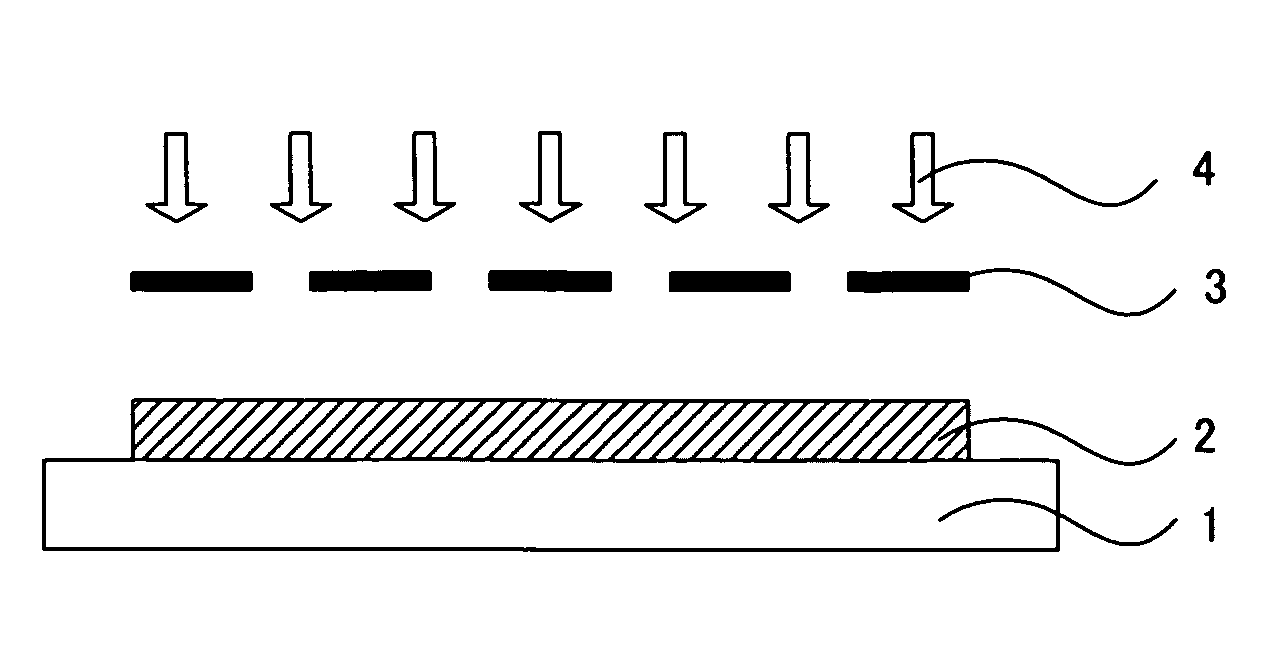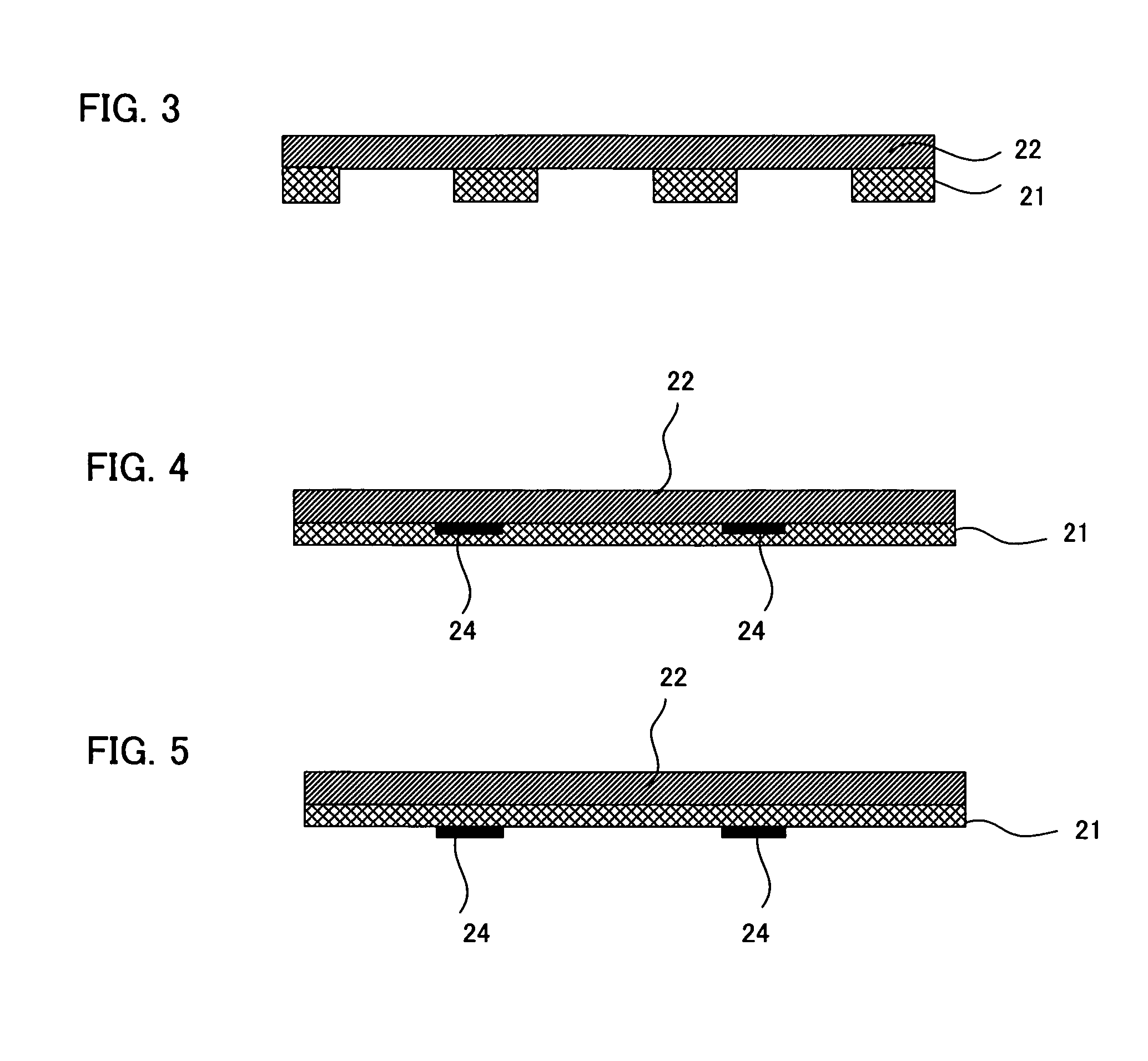Method for manufacturing cell culture substrate
a cell culture substrate and manufacturing technology, applied in the field of cell culture substrate production, can solve the problems of difficult application of patterning methods to the case of cells which cannot be easily obtained, loss generated out of used cells, etc., to achieve high-quality cell culture substrate, prevent cell extinction or damage, and improve cell activity.
- Summary
- Abstract
- Description
- Claims
- Application Information
AI Technical Summary
Benefits of technology
Problems solved by technology
Method used
Image
Examples
third embodiment
(3) Third Embodiment
[0212] The third embodiment of the present process is performed when the patterning substrate is the third embodiment, and is a process of irradiating energy from a given direction, thereby forming a pattern composed of a cell adhesion-inhibiting portion where the cell adhesive material comprised in the cell adhesive layer is decomposed or denatured, and a cell adhesion portion which is other than the cell adhesion-inhibiting portion.
[0213] In the embodiment, energy is irradiated in a pattern form for forming the cell adhesion-inhibiting portion, thereby exciting the photocatalyst in the photocatalyst-containing layer so that the cell adhesive material can be decomposed or denatured. It is therefore possible to render the region irradiated with energy the cell adhesion-inhibiting portion, where the cell adhesive material is decomposed or denatured, and render the region not irradiated with the energy the cell adhesion portion, where the cell adhesive material re...
fourth embodiment
(4) Fourth Embodiment
[0215] The fourth embodiment of the present process is performed when the patterning substrate is the fourth embodiment, and is a process of irradiating energy from a given direction, thereby forming a pattern composed of a cell adhesion portion where the cell adhesion-inhibiting material comprised in the cell adhesion-inhibiting material layer is decomposed or denatured and a cell adhesion-inhibiting portion which is other than the cell adhesion portion.
[0216] In the embodiment, energy is irradiated in a pattern form for forming the cell adhesion portion, thereby exciting the photocatalyst in the photocatalyst-containing layer so that the cell adhesion-inhibiting material can be decomposed or denatured. It is therefore possible to render the region irradiated with energy the cell adhesion portion, where the cell adhesion-inhibiting material is decomposed or denatured, and render the region not irradiated with the energy the cell adhesion portion, where the cel...
fifth embodiment
(5) Fifth Embodiment
[0219] The fifth embodiment of the present process is performed when the patterning substrate is the fifth embodiment, and is a process of arranging the cell adhesive layer and a photocatalyst-containing layer side substrate having a base body and a photocatalyst-containing layer comprising a photocatalyst to dispose the cell adhesive layer and the photocatalyst-containing layer facing each other, and then irradiating energy onto the resultant from a given direction, thereby forming a pattern composed of a cell adhesion-inhibiting portion where the cell adhesive material comprised in the cell adhesive layer is decomposed or denatured, and a cell adhesion portion which is other than the cell adhesion-inhibiting portion.
[0220] As shown in, for example, FIGS. 2A and 2B, in the energy irradiating process of the embodiment, a cell adhesive layer 12 formed on a base material 1 and a photocatalyst-containing layer side substrate 23, having a photocatalyst-containing la...
PUM
| Property | Measurement | Unit |
|---|---|---|
| thickness | aaaaa | aaaaa |
| thickness | aaaaa | aaaaa |
| thickness | aaaaa | aaaaa |
Abstract
Description
Claims
Application Information
 Login to View More
Login to View More - R&D
- Intellectual Property
- Life Sciences
- Materials
- Tech Scout
- Unparalleled Data Quality
- Higher Quality Content
- 60% Fewer Hallucinations
Browse by: Latest US Patents, China's latest patents, Technical Efficacy Thesaurus, Application Domain, Technology Topic, Popular Technical Reports.
© 2025 PatSnap. All rights reserved.Legal|Privacy policy|Modern Slavery Act Transparency Statement|Sitemap|About US| Contact US: help@patsnap.com



